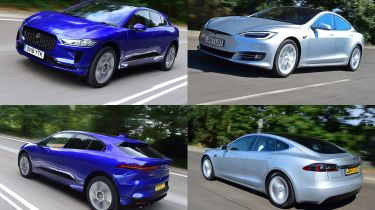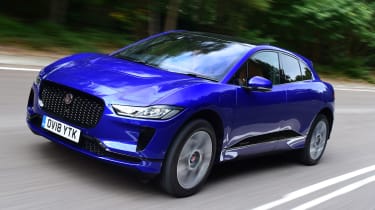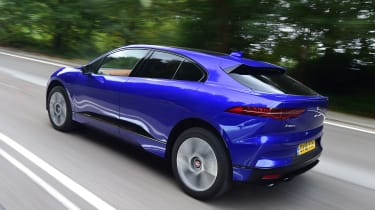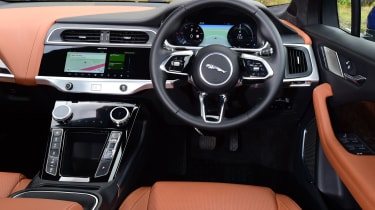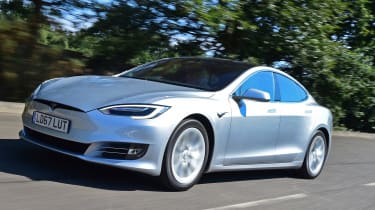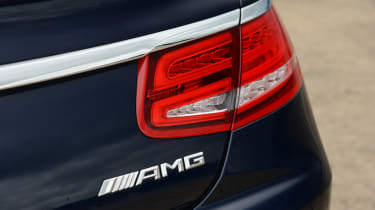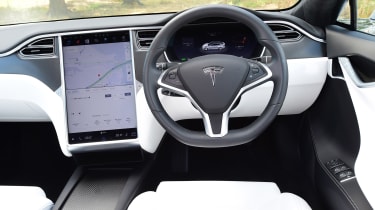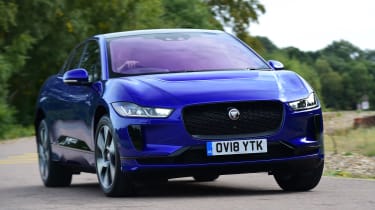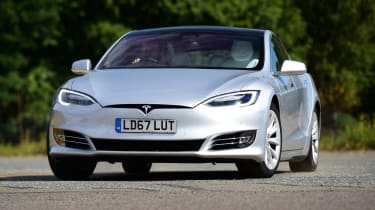Jaguar I-Pace vs Tesla Model S
Is the Jaguar I-Pace or Tesla Model S the better electric car? We find out in a battle of battery power
Electric cars are the future. Just look at the interest, with every big car maker scrambling to get their first EVs to market. But two premium brands have viable offerings already on sale.
The newest is the Jaguar I-Pace. It’s an all-electric model billed as an SUV. This first EV from the British firm boasts advanced tech under its modern-looking skin, but it’s not the only way. Despite its SUV tag, the I-Pace is closer in size and concept to Tesla’s Model S – the five-door that led the premium EV charge and, in 75D form here, a direct rival to the Jag.
Both vehicles claim a range of around 300 miles, so they’ll be viable 99 per cent of the time for many people. But which is the best upmarket EV on sale?
Jaguar I-Pace
For: Performance, enjoyable to drive, usable real-world driving range.
Against: Not as practical as Tesla (but still very usable), infotainment still not the best.
Of the established conventional motor manufacturers, Jaguar beat all of its rivals to market with a pure-electric vehicle. The brand has been first with many innovations over the years, including disc brakes back in the fifties, so the I-Pace’s arrival shouldn’t really come as a shock – and Jag has backed up its speed of development with impressive execution.
Used - available now

2014 Audi
A1 Sportback
91,000 milesManualDiesel1.6L
Cash £6,450
2017 Ford
Fiesta
76,000 milesManualPetrol1.2L
Cash £4,975
2021 MINI
5-Door Hatch
28,985 milesManualPetrol1.5L
Cash £13,629
2021 MINI
5-Door Hatch
28,407 milesAutomaticPetrol1.5L
Cash £15,134If you’ve never driven an EV before, it’s easy. The lack of gears and engine noise is a novelty at first, but it quickly becomes natural – especially with 395bhp and 696Nm of torque on tap.
The I-Pace weighs 2,133kg due to the big 90kWh lithium-ion battery, so acceleration is dulled a little, but at our test track the SUV still sprinted from 0-60mph in 4.4 seconds, which is a sports car’s level of performance.
In effect there’s only one gear, so you drop the Jag into Drive and just go, with the instant torque giving lots of flexibility. The I-Pace romped from 30 to 70mph (simulating accelerating out of a town or village or onto a motorway) in 3.7 seconds.
You can add refinement to that list, because there’s no engine noise to disrupt the calm of the cabin. You hear stones pinging off the body and a little wind and tyre noise at higher speeds, but it’s mostly well suppressed and certainly no noisier than Jag’s other, larger SUV, the F-Pace.
The ride quality matches the refinement. Our car had Jaguar’s £1,100 adaptive air suspension, and even riding on 20-inch alloys, the I-Pace is settled. As with most models on big wheels, the composure is upset by thumping potholes, but otherwise the air-sprung set-up takes most roads in its stride. The car’s weight helps, because you feel it smoothing out the suspension’s responses, so when you factor in the plush damping in the default driving mode, you’ll welcome the comfort here. It’s certainly not as crashy as the Tesla.
Yet it’s also the more engaging car to drive. The steering has a lovely, meaty weight. Despite the taller ride height, it turns sweetly and doesn’t roll all that much, because the heavy battery is sandwiched low down in the floor. Grip is good and, with four-wheel drive, so is traction.
Even this S-spec car has everything you’d need: a 12.3-inch digital dash, twin touchscreens (10 and five-inch), LED lights, a Meridian stereo, reversing camera, cruise and climate control, lots of safety kit and even CarPlay and Android Auto, which haven’t graced Jags until now. Choice options included the pricey but nice £3,940 heated Performance front seats and £960 panoramic roof.
Testers’ notes:
- Infotainment: Multimedia set-up still isn’t the greatest, but you can now get Apple CarPlay and Android Auto in a Jaguar. It can’t stop screen reflections, though.
- Quality: I-Pace cabin feels better built than Model S’s. Soft leather sports seats are comfortable and supportive, and the driving position is great.
- Steering: Wheel is lovely and steering offers a nice weight. The 12.3-inch digital dashboard is an appealing hi-tech feature providing info on efficiency.
Tesla Model S
For: Great performance, strong infotainment system, impressive practicality.
Against: Ride quality can’t match Jaguar’s, not as nice to drive, pricier than I-Pace and trails on quality.
Tesla might have been in the news for its controversial CEO Elon Musk more recently, but that shouldn’t detract from what the company has achieved in its short existence or the success of its products.
The Model S is the car that really launched Tesla as a motor manufacturer, mixing plenty of usable range with strong performance. The higher-powered versions have made headlines with incredible 0-60mph times thanks to their Ludicrous mode, but this entry-level (again, a relative term) 75D version is still incredibly rapid by conventional car standards.
With 362bhp and 660Nm of torque, the Tesla was actually faster than the Jag over the benchmark sprint, taking 4.3 seconds. It was also 0.2 seconds quicker from 30 to 70mph.
Performance certainly isn’t in question, but while the two are closely matched on acceleration, the Model S slips in other areas that buyers prioritise in such premium cars.
Air suspension is standard, but despite this, our car’s 19-inch alloys thumped over bumps as the chassis struggled to iron out imperfections in the road like the more compliant I-Pace.
There’s not a lot of feel through the Jag’s steering, but it’s more consistent and more faithful than the Tesla’s set-up. It’s light and, surprisingly, there’s about as much roll in faster corners as in the Jaguar. While it’s agile, the Model S doesn’t steer or change direction quite as hard as its British rival, even if there’s a similarly instant response from the motors.
The ‘75’ in the Tesla’s name denotes its 75kWh battery pack, so although it’s a little down on the Jag’s, with a claimed range of 304 miles (vs a 298-mile NEDC claim for the Jag), there’s a similar level of usability on offer.
While the Jag has rapid charging capability, the Model S can be recharged using Tesla’s Supercharger network. This has 120kW charging, which should take the battery to 80 per cent in around 40 minutes. On a 50kW fast charger to match the I-Pace, the Tesla can be fully recharged in 90 minutes, instead of one hour 25 minutes for an 80 per cent top-up in the Jag. On a low-power supply the Model S takes seven hours.
Other kit includes a 17-inch infotainment screen – yes, really – Internet capability, sat-nav, heated leather seats, a powered tailgate and lots of safety equipment. The cars are well matched on spec, but while the Tesla’s cabin looks cool, it trails the Jag’s on quality and isn’t as solidly built.
Testers’ notes
- Display: Dash display adds to Tesla’s hi-tech feel, although the quality of the finish inside can’t match that of the I-Pace.
- Touchscreen: Huge 17-inch display takes centre stage in Tesla’s cabin. It’s really comprehensive, but the features accessed within it can take some finding.
- Steering: Wheel provides even less feel than the Jaguar’s; Model S’s set-up is a bit inconsistent and is too light for our liking.
Verdict
First place: Jaguar I-Pace
The I-Pace is our Car of the Year for good reason. It’s fast, refined, great to drive and offers low running costs, and is cheaper than the Tesla. It might require some adaptation of your lifestyle, but not much. There’s no better EV to embrace the change with.

Second place: Tesla Model S
There’s no doubt Tesla has done a lot for the electric car, but the Model S 75D doesn’t make as compelling a case as the Jag. Even though it’ll be cheap to run and is practical, this isn’t enough for it to beat the I-Pace, because it’s not as comfortable and doesn’t drive as well.

